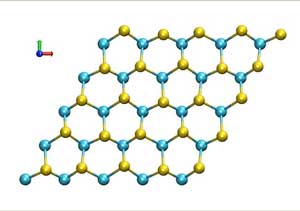| Sep 19, 2019 | |
2-D atoms do the twist(Nanowerk News) It is well known that atoms in a crystal vibrate when heated, creating collective excitations. This leads to the propagation of vibrational waves (phonons), which are similar to the ripples seen on the surface of water. |
|
| In the study (Science, "Observation of chiral phonons"), scientists demonstrated, for the first time, an intrinsically rotating form of motion for the atoms in a crystal. | |
| The observations were on collective excitations of a single molecular layer of tungsten diselenide. Whether the rotation is clockwise or counter-clockwise depends on the wave’s propagation direction. The observation means that there is a chirality associated with the phonon transport. | |
 |
|
| Waves of heat, called phonons, cause atoms to rotate in a certain direction. Selenium atoms (yellow) collectively go through a clockwise circular atomic motion while the tungsten atoms (blue) don’t move. (Image: Lawrence Berkeley National Laboratory) | |
| In this study, researchers have observed, for the first time, that atoms rotate clockwise or counter-clockwise when they transport phonons. This rotation could become the building block for energy-efficient information tech. It could also enable the development of molecular-scale rotors to drive microscopic motors and machines. | |
| Chirality associated with the transport of electrons controls important electrical phenomena in materials. In addition, scientists discovered that phonons could also have a chirality associated with their movement in a solid, which can influence the properties of the material. | |
| The phenomenon was first observed in laser-excited tungsten diselenide monolayers. In their measurements, the scientists used a combination of two ultrafast laser pulses to optically excite the crystal and generate phonons propagating in a particular direction. | |
| At the same time, they observed a clear difference in absorption between left- and right-circularly polarized infrared light, which confirmed the chiral nature of the phonons. Theoretical predictions provide an understanding of the phenomena: in one phonon mode, selenium atoms collectively go through a clockwise circular atomic motion, while tungsten atoms do not move. | |
| In a different mode, the collective circular motion of the tungsten atoms is clockwise, and the selenium atoms’ circular motion is counter-clockwise. Learning to control this circular motion could lead to the development of exotic electronics and new capabilities for energy-efficient information processing. |
| Source: U.S. Department of Energy, Office of Science | |
|
Subscribe to a free copy of one of our daily Nanowerk Newsletter Email Digests with a compilation of all of the day's news. |
